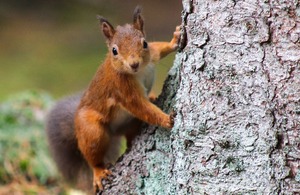Surge in red squirrels spotted on Scottish defence training estate
The Defence Infrastructure Organisation (DIO) is excited to reveal an increase in red squirrel sightings on Kirkcudbright Training Area in Dumfries and Galloway.

Copyright: Pearse O’Halloran.
Sightings of the red squirrel species have almost doubled in recent months, with the surge thought to be the result of dedicated conservation work by DIO and its partners.
The increase in sightings comes ahead of Red Squirrel Appreciation Day, and follows months of work by DIO and the Dumfries and Galloway Pine Marten Group on a project that aims to increase the number of pine martens at Kirkcudbright sustainably. Pine martens are natural predators of squirrels, but red squirrels are much more cautious of them than their grey cousins, giving them a chance to thrive.
DIO’s Deputy Training Safety Officer for Kirkcudbright Training Centre, WO2 Scott Maclean, has been working on the project and is delighted with the resurgence of the species. He said:
There has been a notable increase of red squirrel activity across the estate at Kirkcudbright, with roughly double the number of sightings in the last few months than before, in 5 or 6 separate locations.
There have also been several sightings of pine martens by Kirkcudbright Training Centre staff and members of the public in the Balmae Lake area of the estate. The presence of pine martens is clearly having a beneficial impact on the red squirrel population.
The red squirrel is the UK’s only native squirrel species, and populations have been declining since the introduction of the grey squirrel from North America during the 19th century. The UK red squirrel population has fallen from around 3.5 million to just a few hundred thousand, compared to the estimated population of 2.7 million grey squirrels. Competition and disease transmission, notably squirrel pox (which is fatal to red squirrels but does not affect the greys) are the main drivers for the decline. The red squirrel is now classified as endangered in England and Wales.
Conservation projects to boost red squirrel numbers are building on emerging non-lethal methods of controlling grey squirrel populations, such as the introduction of pine martens.
This project was made possible by funding from DIO’s Conservation Stewardship Fund, including for the installation of 12 pine marten den boxes. These replicate large tree cavities which are not very common, and form a safe area where pine martens can breed and spend the winter.
While there is evidence of existing pine marten activity in the area, it was mostly migratory. The installation of the den boxes was designed to help a small, permanent pine marten population to develop, helping to reduce grey squirrel numbers and encourage a resurgence of the reds.
Kirkcudbright Training Centre is primarily used for infantry training, including live firing, and stretches over approximately 1,900 hectares. Sustainably managing the land and wildlife is extremely important to DIO, with fauna and flora thriving on many of the UK’s military training areas.
Oliver Howells, DIO’s Principal Ecologist, said:
The conservation of native species is an important part of the work we carry out across the UK and overseas defence estate. Our ecologists, as well as dedicated Training Safety Officers like Scott are working hard to deliver military training requirements, while supporting the recovery of some of the most threatened and iconic species in the UK.
Wildlife continues to thrive across our training areas, and there are many examples of how priority species are flourishing alongside military activities. The rise in red squirrel numbers at Kirkcudbright is a great example and a real success story.
The work to establish a permanent pine marten population started as part of a wider project to rejuvenate the Balmae Lake region of Kirkcudbright Training Area. Non-native plant species such as rhododendron, montbretia and bamboo have been removed and replaced with Scottish wildflowers, in hopes of increasing insect numbers and species diversity in the region.